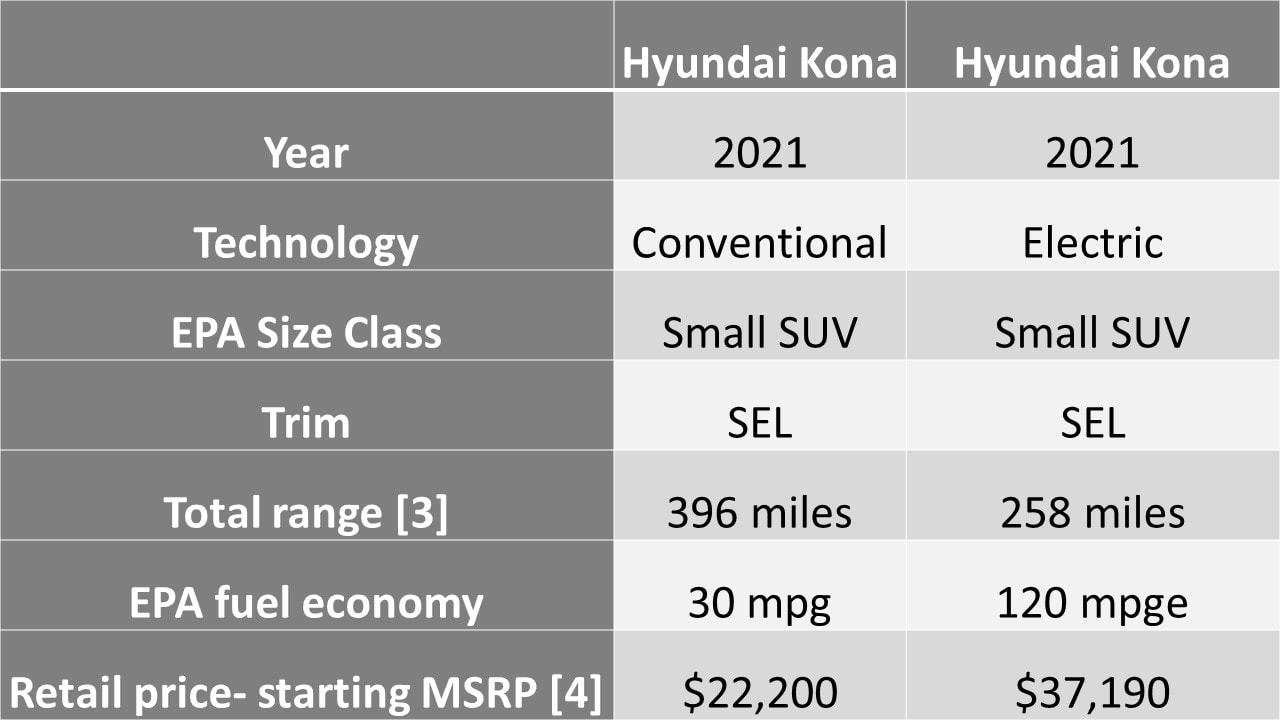|
Consumer Reports recently released a report titled: Electric vehicles Ownership Costs: Todays Electric Vehicles Offer Big Savings for Consumers [1]. As discussed below, the analysis in the Consumer report is highly localized. The report because of its apples-to-oranges type analysis can mislead the general population and policy makers from the viewpoint of understanding the CO2 reduction cost effectiveness of electric vehicles. Some related issues with the report analysis [1] are listed below-
A concern with the above localized analysis is that it could be misinterpreted and indirectly lead to poor policy decisions and correspondingly inefficient climate change mitigation. Effective policy decisions involve providing subsidies/incentives for the most effective replacement solutions. The above requires a robust prioritization analysis of the proposed replacement technology solutions which includes a cost-effectiveness analysis. In order to understand the cost-effectiveness of the solutions, the technology evaluation analysis should NOT include subsidies and short-term local discounts. A robust analysis should highlight the intrinsic cost related to the new technology and consider all relevant major costs. Such an analysis is briefly provided below. The best approach to compare the conventional and electric vehicle technologies is by considering vehicles with the same trim from the same manufacturer. Such data is available for Hyundai Kona. To facilitate a robust comparison between conventional and electric vehicle technology in this analysis, a Hyundai Kona conventional vehicle is compared with Hyundai Kona electric vehicle with the same trim (SEL) (Table 1). Table 1. Comparison of conventional and electric vehicle technologies using Hyundai Kona as a surrogate [4,5]
Using Table 1 data and other necessary information [6], the total cost of ownership for the current electric vehicle technology is estimated to be at-least three thousand dollars higher than the conventional vehicle technology, which is an opposite result compared to the Consumer report analysis (which indicates several thousand dollars lower total ownership cost for electric car technology). The result obtained in this analysis is in excellent agreement with a recent detailed study from the MIT Energy Initiative [7]. The contradictory results with respect to the consumer report are expected considering that the effect of technology on vehicle price is grossly dampened in the report because of a lack of an apples-to-apples comparison [8]. Based on Table 1 and other apples-to-apple comparisons [7,9,10], the electric vehicle technology currently has 50 to 65 % higher upfront investment cost compared to a conventional vehicle. This leads to major concerns about the cost effectiveness of current electric vehicle technology for climate change mitigation. Since it is important to decrease annual CO2 emissions rapidly, providing subsidies to a technology with relatively high upfront costs disallows efficient use of our limited resources. This stems from the fact that there are several other technologies with much lower upfront costs that provide far more cost-effective CO2 emission reductions [10]. As a result, policy decisions that will subsidize the current electric vehicle technology will take away from other technologies that are far more effective in CO2 reduction; i.e. such policy decisions will decrease climate change mitigation effectiveness. Note, this discussion pertains to policy decisions; i.e. individuals and organizations that can afford it should be encouraged to utilize electric vehicle technology (just not at the taxpayer expense). Some technology comparison examples will be discussed in upcoming blogs. However, if a reader would like access to the information right away it can be found in a recently released book, which focuses on the practical effectiveness comparison of different CO2 reduction technologies [10]. References/Notes (websites last accessed on Nov. 1, 2020) [1] Consumer Reports, October 2020. https://advocacy.consumerreports.org/wp-content/uploads/2020/10/EV-Ownership-Cost-Final-Report-1.pdf [2] Official Nissan website: https://www.nissanusa.com/shopping-tools/build-price/cars/nissan-leaf/2020/62-kwh/28971:BABWy:AsKD5hU/exterior [3] Note: Historically a replacement technology has succeeded on a widescale only if was at-least equivalent to the incumbent technology in terms of all the main characteristics. From Table 1 it is clear that the conventional vehicle has a large total driving range advantage over the electric vehicle version. This condition is clearly not met for the current electric vehicle technology. In other words, the direct comparison between the technologies as considered in Table 1 is giving a significant benefit of doubt to the electric vehicle technology; i.e. it is assuming that the driving range disadvantage will soon be overcome via technology improvements. [4] Official Hyundai website: https://www.hyundaiusa.com/us/en/vehicles/kona/sel; https://www.hyundaiusa.com/us/en/vehicles/kona-electric/sel [5] Official US Government website for fuel economy information: https://www.fueleconomy.gov/feg/Find.do?action=sbs&id=42089&id=41421&#tab1 [6] Fuel costs were obtained directly from official US Government website for fuel economy information (reference 4); gasoline price based on baseline case for annual energy outlook U.S. EIA (https://www.eia.gov/outlooks/aeo/); Maintenance cost $0.031/mile for electric vehicles and $0.061/mile for conventional vehicle (from reference 1: Table 2.1); home charger equipment and installation cost: $1000; sales tax: 6% (nationwide average- https://auto.howstuffworks.com/under-the-hood/cost-of-car-ownership/cost-of-taxes-on-your-car1.htm); interest rate: 3% (this is too low based on historical U.S. market return on investment but used here only to match with reference 1: https://www.businessinsider.com/personal-finance/average-stock-market-return); vehicle insurance: 10% higher annual cost for electric vehicles (lower end value based on https://www.valuepenguin.com/how-having-electric-car-affects-your-auto-insurance-rates); lifetime vehicle miles: 200,000 miles (similar to reference 1). [7] MIT Energy Initiative, Insights into Future Mobility (2019): http://energy.mit.edu/wp-content/uploads/2019/11/Insights-into-Future-Mobility.pdf [8] Note: Since the vast majority of the discrepancy between the consumer report analysis and the above analysis and the MIT analysis is directly related to upfront investment (i.e. vehicle retail price), the estimation example based on Table 1 is adequate for a general understanding of cost of total ownership of electric vehicles. [9] McKinsey & Company. Making electric vehicles profitable: https://www.mckinsey.com/industries/automotive-and-assembly/our-insights/making-electric-vehicles-profitable [10] Critical comparison of low-carbon technologies: A practical guide to prioritizing energy technologies for climate change mitigation. https://www.amazon.com/dp/B08LP8TRLP
0 Comments
Leave a Reply. |
Tushar ChoudharyAuthor, Scientist, Innovator Archives
February 2024
Categories |


 RSS Feed
RSS Feed